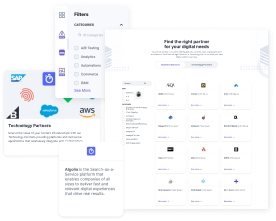

Contentstack glossary
Here, you will find definitions of terms related to headless CMS technology and links to additional resources.

API first
API first is an approach where the development of an application or system starts by designing and implementing the application programming interfaces (APIs) first, before building the user interface or other components. By prioritizing the API design, developers can ensure that the core functionality and data access of the application are well-defined and optimized for integration with other systems or platforms. API first development promotes modularity, reusability and interoperability.
API first companies
API-first companies are organizations that prioritize the development and design of their application programming interfaces (APIs) as a core aspect of their business strategy. These companies adopt an API-centric approach by placing APIs at the forefront of their product or service offerings. They consider APIs not only as a means to connect their own systems but also as a way to enable integration with third-party developers, partners or clients.
CMS e-commerce
CMS e-commerce refers to integrating a content management system (CMS) with an e-commerce platform. It combines the capabilities of a CMS, which manages and delivers content, with e-commerce functionalities such as product catalog management, shopping cart, and payment processing. CMS e-commerce solutions enable businesses to create and manage content-rich websites while seamlessly incorporating e-commerce features to sell products or services online.
Cloud content management
Cloud content management refers to digital content storage, management, and delivery through cloud-based platforms. It encompasses the functionalities of traditional content management systems, such as document management, collaboration, version control, and access control, but with the added benefits of scalability, accessibility, and ease of integration. Cloud content management enables organizations to store and manage content securely in the cloud, making it accessible from anywhere and facilitating seamless collaboration.
Composable commerce
Composable commerce refers to an approach where e-commerce systems are built by composing modular and independent services or microservices. Instead of relying on monolithic platforms, composable commerce enables businesses to select and combine specialized services, such as payment gateways, product catalogs, inventory management or marketing tools, to create a customized e-commerce solution. This approach provides flexibility, scalability and the ability to adapt to changing business needs.
Content+cloud
Content+cloud refers to an integrated approach where content management systems (CMS) or digital asset management (DAM) systems are combined with cloud computing technologies and services. It involves leveraging cloud-based infrastructure, storage and computing power to enable efficient content management, delivery and scalability. Content+cloud solutions provide organizations with the benefits of cloud computing, such as accessibility, scalability and cost-efficiency, while managing and delivering their content effectively.
Digital asset management
Digital Asset Management organizes, stores, and distributes digital assets such as images, videos, documents, and audio files in a centralized system. DAM systems provide tools for tagging, metadata management, versioning, and searching, allowing users to locate and retrieve assets efficiently when needed. DAM helps streamline content creation, collaboration, and distribution processes, ensuring brand consistency and enhancing digital asset reuse.
Digital asset management systems
A digital asset management (DAM) system is a software solution that stores, organizes, and distributes digital assets. It provides a centralized repository where users can upload, manage metadata, search, and retrieve assets efficiently. DAM systems often include features such as version control, rights management, workflow automation, and analytics, allowing organizations to optimize their digital asset workflows, maintain brand consistency, and enhance content distribution.
Headless commerce
Headless commerce refers to an architecture where the front-end presentation layer (the "head") and the back-end e-commerce functionality (the "body") are decoupled. In this approach, the e-commerce platform's back end serves as a headless content management system (CMS) or an e-commerce engine, while the front-end presentation layer is built separately and can be delivered through various channels such as websites, mobile apps, IoT devices or voice assistants. Headless commerce enables flexibility, scalability and the ability to deliver consistent experiences across multiple touchpoints.
Headless commerce architecture
Headless commerce architecture is an approach where the front-end presentation layer and the back-end e-commerce functionality are decoupled. This architecture allows for greater flexibility and scalability by separating the user interface from the e-commerce engine. In a headless commerce architecture, the e-commerce engine serves as an API-driven back end, providing data and functionalities to multiple front-end touchpoints such as websites, mobile apps, or IoT devices.






9cb7.jpeg?format=pjpg&auto=webp)

